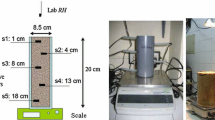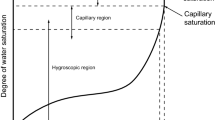Abstract
Humidity field in the concrete may be found by solving the diffusion differential equation. The discussion of possible boundary conditions was done on the example of the infinite concrete cylinder, drying upon its surface. Two proposed boundary conditions lead to very similar solutions, provided that the evaporation coefficient at the surface is high enough. A comparison with the experimental results was made. Linear diffusion equation does not describe the drying process adequately. Diffusion coefficient has been suggested to be a quadratic function of the humidity, and the corresponding nonlinear equation has been solved by the numerical way.
Résumé
Le champ d'humidité dans le béton peut être défini en résolvant l'équation différentielle (1) de diffusion. On examine les conditions aux limites possibles—(3) et (4)—à l'aide de l'exemple du cylindre de béton infini, entièrement saturé au début et se desséchant en surface. Les deux types de conditions aux limites mènent à des solutions très voisines, à condition d'avoir un coefficient d'évaporation—h dans l'équation (4)—suffisament élevé. On compare avec les résultats expérimentaux. L'équation de diffusion linéaire ne décrit pas le processus de séchage de façon adéquate. On propose de considérer le coefficient de diffusion D comme une fonction quadratique de l'humidité (8). L'équation non linéaire correspondante (9) a été résolue par les différences finies (10).
Similar content being viewed by others
Abbreviations
- w :
-
humidity of concrete—non dimensional
- t :
-
time—dimensional or non-dimensional
- ∇2 :
-
Laplacian
- D :
-
diffusion coefficient—non-dimensional or dimensional (cm2h−1)
- x :
-
position vector
- ℬ:
-
region occupied by the body under consideration
- w o :
-
initial humidity of concrete
- w z :
-
equivalent environment humidity
- δℬ:
-
surface of the regionℬ
- n :
-
outside versor normal to σ“
- h :
-
coefficient of evaporation at the surface, non-dimensional or dimensional (cm−1)
- ϱ:
-
radial component of cylindrical coordinates—non-dimensional
References
Carslaw H.S., Jaeger J.C.—Conduction of heat in solids. Clarendon Press, Oxford, 1947.
Kasperkiewicz J.—Shrinkage stresses and strains in concrete (in Polish). Dr-s thesis. Institute of Fundamental Techn. Research, Warsaw, 1971.
Carlson R. W.—Drying shrinkage of large concrete members. ACI Journal, 1937, 327–336.
Pickett G.—Shrinkage stresses in concrete. ACI Journal, 17, 1946, 165–204 (p. I), 361–398 (p. II).
Aleksandrovskij S.V.—About moisture and thermal properties of concrete connected with heat and moisture transport (in Russian), Issl. svoistv bet. i Železobet. constr.—TrudyNiižib, vyp. 4, Gosstrojizdat 1959, 184–214.
Rostásy F.S.—Zur Theorie des Austrocknung und des Schwindens zementgebundener Massen. Zement-Kalk-Gips 13, 3, 1960, 93–103.
Hancox N.L.—The diffusion of water in concrete. UKAEA Rap., AEEW-R 482, Winfrith, 1966.
Hancox N.L.—The role of moisture diffusion in the drying of cement paste under the influence of temperature gradients. Brit. J. Appl. Phys., ser. 2, 1, 1968, 1769–1777.
Jain K.K., Kesler C.E.—Moisture exchange behavior in concrete and mortar. T.a.A.M. Report 646, Univ. of Illinois, July 1964.
Lott J.L., Kesler C.E.—Service behavior of concrete for radiation shielding. Mat. Res. a. Stands, 7, 9, Sept. 1967, 375–382.
Author information
Authors and Affiliations
Rights and permissions
About this article
Cite this article
Kasperkiewicz, J. Some aspects of water diffusion process in concrete. Mat. Constr. 5, 209–214 (1972). https://doi.org/10.1007/BF02474070
Issue Date:
DOI: https://doi.org/10.1007/BF02474070




